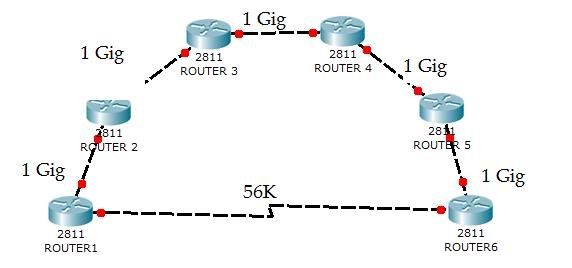Metrics/Hop Counts
in CCNA & CCENT
I believe Metric and Hop Counts are the same thing from what I've read. Their just synonomous and used interchangeably.. Correct me if I'm wrong.
Secondly and more importantly.
Are Hop Counts determined by the amount of routers it hopped to, to get to it's destination or by the amount of interfaces it has to go through to arrive at it's destinaton?
Example: Say you have 3 Routers.
Router A
Router B
Router C
(Router B is in the middle and bridging between A & C)
Router A sends a RIP Update to C. (Each bolded interface represents the hop)
So would that be a hop count of 3 ? Router A Packet leaves S 0/0 - Enters Router B S0/0 -Leaves Router B S0/1 - Arrives at Router C S0/0
Or Just a Hop Count of 2? Packet goes to Router B then to C - Hence, 2 Hops.
Which is it?
Secondly and more importantly.
Are Hop Counts determined by the amount of routers it hopped to, to get to it's destination or by the amount of interfaces it has to go through to arrive at it's destinaton?
Example: Say you have 3 Routers.
Router A
Router B
Router C
(Router B is in the middle and bridging between A & C)
Router A sends a RIP Update to C. (Each bolded interface represents the hop)
So would that be a hop count of 3 ? Router A Packet leaves S 0/0 - Enters Router B S0/0 -Leaves Router B S0/1 - Arrives at Router C S0/0
Or Just a Hop Count of 2? Packet goes to Router B then to C - Hence, 2 Hops.
Which is it?
Comments
-
 luke_bibby
Member Posts: 162
If the routing protocol uses hop counts solely to determine the best path to a destination - e.g. RIP and RIP 2 - then yes the terms and synonymous. Otherwise they do not mean the same thing.
luke_bibby
Member Posts: 162
If the routing protocol uses hop counts solely to determine the best path to a destination - e.g. RIP and RIP 2 - then yes the terms and synonymous. Otherwise they do not mean the same thing.
Other routing protocols use different ways to determine the best path toa destination subnet. OSPF for example adds up all the 'costs' to reach a destination, where cost = 100Mbps / interface-bandwidth-in-mbps.
The hop count would be 2 to reach the subnet connected to Router A from Router C - you don't have to hop over yourself
-
 godofthunder9010
Member Posts: 21 ■□□□□□□□□□
Firstly, I appologize that this is a tad thrown together.
godofthunder9010
Member Posts: 21 ■□□□□□□□□□
Firstly, I appologize that this is a tad thrown together.
Okay, in this picture we are representing several router spread out throughout a business campus. The first and last router just happen to be connected by 56K phone line connection. RIP is the only routing protocol (at least among the CCNA relevant ones) dumb enough to completely disregard the Gigabit routes in favor of a 56K connection. The first and last router will communicate at a crawl when they could be communicating at blazing fast speeds.
Hop count as a metric is only used by RIP and it's the only thing RIP cares about. For this reason, you will rarely see RIP implemented in large networks. Big networks can have legacy gear and legacy wiring in places. You don't want your routing protocol making really bad decisions on you just because someone plugged a phone line into an old dial-up modem, etc.
Now if you want to know the Hop Count in that picture, count the Routers. Start at Router 1. How many routers do you have to hit before you hit the last router (for the purpose of this example, that is your destination.) So we generally count the number of devices. If you want a good way to remember, think of it like a frog jumping from lily pad to lily pad. It gets there on the 5th jump. That's 5 hops. RIP will look at that and the single 1 Hop route on the 56K line, and it will choose the 1 Hop every time.
EIGRP and OSPF use completely different metrics from this to decide which route to use. Those methods are also called metrics of course.
-
 godofthunder9010
Member Posts: 21 ■□□□□□□□□□
I should add, from the example picture, RIP will also choose the 56K line to get to ROUTER 5. Why? Because it's 2 Hops vs 4 Hops.
godofthunder9010
Member Posts: 21 ■□□□□□□□□□
I should add, from the example picture, RIP will also choose the 56K line to get to ROUTER 5. Why? Because it's 2 Hops vs 4 Hops.
I'd like to see Cisco come up with a test question example where using RIP in an enterprise network is a good idea. That would be interesting to see.
As Luke said, OSPF uses cost as a metric. OSPF would make the better decision on this network. That's why it gets used in enterprise networks and RIP generally doesn't.
